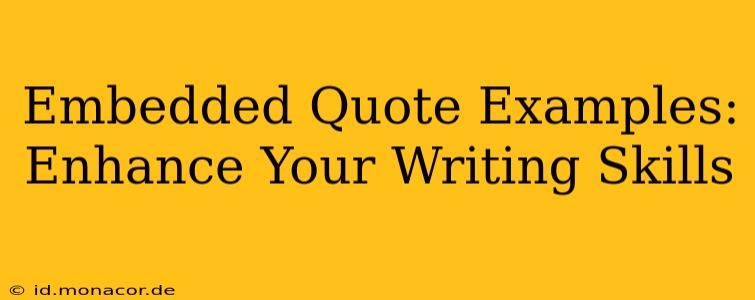Mastering the art of embedding quotes seamlessly into your writing elevates your prose, adds credibility, and strengthens your arguments. Instead of simply dropping quotes into your text, learn how to integrate them effectively to create a cohesive and engaging narrative. This guide explores various techniques and provides examples to help you enhance your writing skills.
What are Embedded Quotes?
Embedded quotes, also known as integrated quotes, are quotes incorporated directly into the flow of your sentence. Unlike block quotes (which are set apart visually), embedded quotes are interwoven with your own words, creating a more fluid reading experience. They're a powerful tool for showcasing evidence, illustrating a point, or adding expert opinion to your writing.
Why Use Embedded Quotes?
Using embedded quotes offers several advantages:
- Improved Flow: They create a smoother, more natural reading experience compared to lengthy block quotes.
- Enhanced Clarity: They directly support your points, making your arguments more convincing.
- Conciseness: They help you avoid lengthy explanations and get straight to the point.
- Stronger Argumentation: They provide concrete evidence to back up your claims.
How to Effectively Embed Quotes
Here are some key techniques for smoothly embedding quotes:
-
Introduce the quote: Always introduce the quote with context. This helps your reader understand the relevance and source of the quote. Use phrases like "According to X," "As Y stated," or "In his book, Z explains."
-
Use short quotes: Keep embedded quotes concise. Long quotes are better suited for block quote formatting. Aim for quotes that directly support your point without unnecessary additions.
-
Integrate grammatically: Make sure the quote flows grammatically with your own sentence. You might need to adjust punctuation or add words to ensure a smooth transition.
-
Use ellipses sparingly: Use ellipses (...) to indicate omitted words within a quote only if it doesn't change the meaning. Overuse of ellipses can be distracting.
-
Use brackets [ ] for changes: If you need to make minor changes to a quote (e.g., changing a pronoun for clarity), use square brackets to indicate the alteration.
Embedded Quote Examples
Let's look at some examples to illustrate different techniques:
Example 1 (Simple Introduction):
"The American Dream, as defined by many, is a promise of upward mobility," explains sociologist Dr. Jane Smith in her recent study.
Example 2 (Integrating the quote into the sentence):
Dr. Smith argues that the "American Dream is increasingly elusive for many working-class families."
Example 3 (Using ellipses):
"The challenges are immense...requiring a multifaceted approach," cautions economist John Doe in his analysis of economic inequality. (Note: The ellipses indicate that some words have been omitted from the original quote for brevity, without altering the meaning.)
Example 4 (Using brackets):
"In their study of urban development, the researchers concluded that '[t]he city's infrastructure needs significant improvement.'" (Note: The brackets indicate a change from the original quote to maintain grammatical consistency.)
Common Mistakes to Avoid
-
Overusing quotes: Don't rely solely on quotes to make your points. Integrate quotes strategically, supporting your own analysis and interpretation.
-
Failing to introduce quotes: Always provide context for your quotes to ensure the reader understands their relevance.
-
Misrepresenting quotes: Never distort or misinterpret a quote to support your argument. Accuracy is paramount.
How to Choose Between Embedded and Block Quotes
The choice between embedded and block quotes depends on the length and importance of the quote. Short, easily integrated quotes work best as embedded quotes, whereas longer, more significant quotes are better suited for block quote formatting.
Conclusion
Mastering the skill of embedding quotes effectively enhances your writing's clarity, flow, and persuasiveness. By following these guidelines and practicing regularly, you'll strengthen your ability to integrate quotes seamlessly into your writing and create compelling and credible arguments. Remember to always provide proper attribution and avoid misrepresenting the original source.

